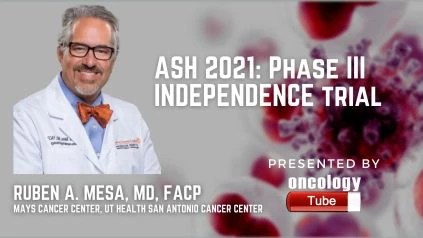Ruben A. Mesa, MD, FACP from Mays Cancer Center, UT Health San Antonio Cancer Center speaks about the ASH 2021 Abstract – 1490 INDEPENDENCE: A Phase 3 Study of Efficacy and Safety of Luspatercept Versus Placebo in Patients with Myeloproliferative Neoplasm-Associated Myelofibrosis on JAK2 Inhibitor Therapy and Requiring Red Blood Cell Transfusions.
Link to Abstract:
https://ash.confex.com/ash/2021/webprogram/Paper145717.html
Background:
Ineffective erythropoiesis, faulty bone marrow (BM) function, and fibrosis, and a higher likelihood of progression to acute myeloid leukemia are all symptoms of myeloproliferative neoplasm (MPN)-associated myelofibrosis (MF) (AML). Anemia is present in up to 60% of patients (pts) at the time of diagnosis, and all pts eventually acquire anemia. Anemia linked with transfusion-dependent MF has few treatment options.
Luspatercept, an erythroid maturation agent, is approved in the United States and the European Union for the treatment of anemia in patients with lower-risk myelodysplastic syndromes with ring sideroblasts who have failed erythropoiesis-stimulating agent (ESA) treatment and need red blood cell (RBC) transfusions, as well as in patients with -thalassemia who need RBC transfusions. A preliminary analysis of a phase 2 trial of luspatercept in patients with MF-associated anemia (NCT03194542) found that 27 percent of patients achieved RBC transfusion independence (RBC-TI) with luspatercept within the first 24 weeks of treatment (Gerds et al. Blood 2020;136[Suppl 1]:4748).
The current phase 3 INDEPENDENCE trial’s eligibility criteria and research design are described here.
Methods and Design of the Study:
INDEPENDENCE is a phase 3 randomized, double-blind trial comparing the efficacy and safety of luspatercept with placebo in patients with MPN-associated MF who require RBC transfusions and are on a JAK2 inhibitor. Patients must be at least 18 years old at the time of consent, have a documented diagnosis of primary MF, post-essential thrombocythemia MF, or post-polycythemia MF, need regular RBC transfusions (defined as 4–12 RBC units/12 wk prior to randomization), and be on concurrent JAK2 inhibitor therapy for at least 32 weeks (on a stable daily dose for at least 16 weeks) prior to randomization. Anemia due to causes other than MPN-associated MF or JAK2 inhibitor therapy, past use of hydroxyurea, ESAs, androgenic steroids, immunomodulatory substances (pomalidomide, thalidomide), or other medications with possible hematopoiesis effects 8 weeks prior to randomization are all reasons for exclusion.
Following the screening, 309 patients will be randomly assigned to receive luspatercept (initial dose 1.33 mg/kg; titration up to 1.75 mg/kg allowed) or placebo subcutaneously every three weeks (Figure). This number of patients will have 90 percent power to detect the difference between the luspatercept and placebo groups’ response rates of 0.35 and 0.17, respectively. In both treatment arms, the best supportive care (RBC transfusions, iron chelation therapy, antiviral, antibiotic, and/or antifungal therapy) is permitted. Baseline RBC transfusion burden and the Dynamic International Prognostic Scoring System (DIPSS) score are two randomization stratification criteria. After 24 weeks of treatment, clinical benefit (CB) will be assessed as RBC-TI for any consecutive 12-week period (during wk 1–24), a reduction in RBC transfusion burden of 50% and 4 RBC units for 12 weeks (during wk 1–24), or an incomplete duration of response (RBC transfusion-free period of 4 weeks immediately up to the end of 24 weeks). Patients who obtain CB can continue to receive luspatercept medication as long as they benefit, or until they experience severe side effects, progress to AML, withdraw consent or meet any other criteria for treatment cessation. The proportion of patients who become RBC transfusion-free over any 12-week period beginning with randomization and ending with week 24 is the study’s primary goal. The Cochran–Mantel–Haenszel statistical test, with randomization variables as strata, will be used to examine the difference in response rates between the luspatercept and placebo arms at a 1-sided significance level of 0.025 for the primary endpoint.
The INDEPENDENCE trial is registered at ClinicalTrials.gov (NCT04717414) and at EudraCT (2020-000607-36).
This abstract was previously published (Mesa et al. HemaSphere 2021;5[Suppl 2]:805–806).

